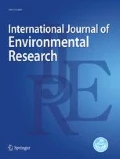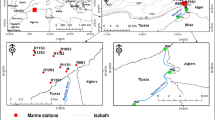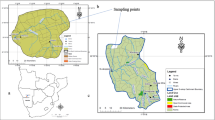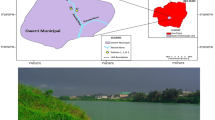Abstract
Currently water resources in nature conservation areas are under severe pressure due to external drivers of anthropogenic pollution. There is a lack of monitoring tools to determine water quality status of dams situated in nature reserves receiving a mixture of pollutants over space and time. The present study was conducted over a 12-month period with the aim of applying a modified pollution index (PILD) to determine the water quality and phytoplankton status of the Loskop Dam situated in the Loskop nature reserve, South Africa. From the data generated in the current study, it was evident that the PILD effectively determined nutrient enrichment and heavy metal pollution in the dam. Furthermore, the study showed that the most pollution tolerant phytoplankton species was the diatom Melosira varians followed by the dinoflagellate Ceratuim hirundinella and the cyanobacteria Microcystis aeruginosa. Chemical variables during the sampling period that exceeded the limits of the South African, Canadian, Australia and New Zealand guideline levels were Zn, TP, Cl, Fe, Mn and NH4. The occurrence of concentrations of Cl above the target water quality range for aquatic ecosystems (5 µgl−1) over the entire sampling period, may have been related to point source sewage pollution in the upper catchment. The PILD showed poor water quality conditions during the months of September and October during the dam’s destratification (lake overturn). By modifying an existing index to incorporate physico-chemical variables that are strongly related to a mixture of pollutants, it should have application on global scale applied to different waterbodies with differ phytoplankton indicator species across different geographical regions. Furthermore, it could also in the future serve as a decision support tool for conservation managers to determine the pollution status of a dam situated in nature conservation areas receiving a mixture of pollutants.
Graphic abstract



Similar content being viewed by others
References
American Public Health Association (APHA) American Water Works Association (AWWA) and Water Pollution Control Federation (WPCF) (1992) Standard Methods for the Examination of Water and Wastewater. APHA, Washington
Australian and New Zealand Environmental Conservation Council (ANZECC) (2000) Guidelines for Fresh and Marine Water Quality, vol 1. Australian and New Zealand Environmental Conservation Council, Australia and New Zealand
Bain MB, Harig AL, Loucks DP, Goforth RR, Mills KE (2000) Aquatic ecosystem protection and restoration: advances in methods for assessment and evaluation. Environ Sci Policy 3:89–98
Bellinger EG, Sigee DC (2010) Freshwater Algae: identification and use as bioindicators. John Wiley & Sons, Ltd, pp 99–132
Berger WH, Parker FL (1970) Diversity of planktonic foraminifera in deep sea sediments. Science 168:1345–1347
Castro-Roa D, Pinilla-Agudelo G (2014) Periphytic diatom index for assessing the ecological quality of the colombian andean urban wetlands of Bogotá. Limnetica 33(2):297–312
CCME (2012) Canadian water quality guidelines for the protection of aquatic life Introduction. Canadian environmental quality guidelines, Canada
Cerón JC, Grande ML, de la Torre ML, Borrego J, Santisteban M, Valente T (2014) Hydrochemical characterization of an acid mine drainage-affected reservoir: the Sancho Reservoir, Huelva, southwest Spain. Hydrol Sci J 59(6):1213–1224
Corbelas M, Rojo C (1994) Factors influencing the share of planktonic diatoms in Lakes. Algol Stud 74:73–104
Dabrowski J, Oberholster PJ, Dabrowski JM, Le Brasseur L, Gieskes J (2013) Chemical characteristics and limnology of Loskop Dam on the Olifants River (South Africa), in light of recent fish and crocodile mortalities. Water SA 39(5):675–686
Dabrowski JM, Dabrowski J, Hill L, Macmillan P, Oberholster PJ (2014) Fate, transport and effects of pollutants originating from acid mine drainage in the Olifants River. South Africa, River Research and Applications
Dabrowski JM (2014D) Applying SWAT to predict orto-phosphate loads in the upper Olifants catchment. Hydrol Earth Syst Sci 18:2629–2643
Dallas HF, Day JA (1993) The effect of water quality variables on riverine ecosystems: a review. WRC Special Report, Pretoria, South Africa
Department of Water Affairs and Forestry (DWAF) (1996) South African water quality guidelines 7 2 aquatic systems. Department of Water Affairs and Forestry, Pretoria, South Africa
Grobler DC, Kempster PL, van der Merwe L (1994) A note on the occurrence of metals in the Olifants River, Eastern Transvaal, South Africa. Water SA 20:195–205
Hamilton DP, Spillman C, Prescott KL, Kratz TK, Magnuson JJ (2001) Effects of atmospheric nutrient input on trophic status of Crystal Lake, Wisconsin. Verhandlungen des Internat Verein Limnol 28:467–470
Hardin G (1960) The competitive exclusion theory. Science 131:1292–1297
Jiang J, Shen Y (2003) Development of a biotic index using the correlation of protozoan communities with chemical water quality. NZ J Mar Freshwat Res 37:777–792
Johnson JD, Jolley RL (1990) Water chlorination: the challenge. In: Jolley RL, Condie LW, Johnson JD, Katz S, Minear RA, Mattice JS, Jacobs VA (eds) Water chlorination chemistry, environmental impact and health effects. Lewis Publishers, London
Kelly MG, Whitton BA (1995) The Trophic Diatom Index: a new index for monitoring eutrophication in rivers. J Appl Phycol 7(4):433–444
Kruger GHJ, Eloff JN (1978) The effects of temperature on specific growth rate and activation energy of Microcystis and Snechococcus isolates relevant to the onset of natural blooms. J Limnol Soc Southern Africa 4:9–20
Kumar A, Cabral-Pinto M, Kumar A, Dinis KM (2020a) Estimation of risk to the eco-environment and human health of using heavy metals in the Uttarakhand Himalaya. India Appl Sci 10:7078
Kumar A, Mishra S, Taxak A, Pandey R, Yu Z (2020b) Nature rejuvenation: Long-term (1989–2016) vs short-term memory approach based appraisal of water quality of the upper part of Ganga River India. Environ Technol Innov 20:101164
Kumar A, Kumar A, Chaturvedi AK, Shabnam AA, Subrahmanyam G, Mondal R, Gupta DK, Malyan SK, Kumar SS, Khan SA, Yadav KK (2020c) Lead toxicity: health hazards, influence on food chain, and sustainable remediation approaches. Internat J Environ Res Pub Health 17:2179
Kumari P, Dhadse S, Chaudhari P R, Wate S R (2008) A biomonitoring of plankton to assess quality of water in the lakes of Nagpur City. The 12th World Lake Conference 160–164.
Lally H, Gormally M, Higgins T, Gammell M, Colleran E (2012) Phytoplankton assemblage in four on cutaway peatlands in Ireland. Royal Irish Acad 112(2):207–216
Lebepe J, Oberholster PJ, Ncube I, Smit W, Luus-Powell WJ (2020) Metal levels in two fish species from a waterbody impacted by metallurgic industries and acid mine drainage from coal mining in South Africa. J Environ Sci Health 55(4):421–432
McCullough CD, Lund MA, May JM (2008) Field-scale demonstration of the potential for sewage to remediate acidic mine waters. Mine Water Environ 27:31–39
Mishra S, Sharma M, Kumar A (2016) Assessment of surface water quality in Surha Lake using a pollution index, India. J Mater Environ Sci 7:713–719
Nalewajko C (1978) Release of organic substances. In: Hellebust JA, Craige JS (eds) Handbook of phycological methods physiological and biochemical methods. Cambridge University Press, Cambridge
Oberholster PJ, Myburgh JG, Ashton PJ, Botha A-M (2010) Responses of phytoplankton upon exposure to a mixture of acid mine drainage and high levels of nutrient pollution in Lake Loskop, South Africa. Ecotoxicol Environ Saf 73:326–335
Oberholster PJ, Botha AM, Chamier J, de Klerk A (2013) Longitudinal trends in water chemistry and phytoplankton assemblage downstream of the Riverview WWTP in the Upper Olifants River. Ecohydrol Hydrobiol 13:41–51
Oberholster PJ, Botha AM, Hill L, Strydom WF (2017) River catchment responses to anthropogenic acidification in relationship with sewage effluent: an ecotoxicology screening application. Chemosphere 189:407–417
Padisák J (1985) Population dynamics of the freshwater dinoflagellate Ceratium hirundella in the largest shallow lake of Central Europe, Lake Balaton, Hungary. Freshw Biol 15:43–52
Palmer CM (1969) A composite rating of algae tolerating organic pollution. J Phytocol 5:78–82
Peine A, Peiffer S (1998) In-lake neutralization of acid mine lakes. In: Geller W, Klapper H, Salomons W (eds) Acidic mining lakes: acid mine drainage, limnology and reclamation. Springer Verlag, Berlin
Peterson CG, Stevenson RJ (1989) Seasonality in river phytoplankton: multivariate analyses of data from the Ohio River and Kentucky tributaries. Hydrobiologia 182(2):99–114
Pollingher U (1988) Freshwater dinoflagellates: Growth, reproduction strategies and population dynamics. In: Sandgren C (ed) Growth and reproductive strategies of freshwater phytoplankton. University of Cambridge, Cambridge, pp 134–174
Reynolds CS (1984) Phytoplankton periodicity: the interactions of form, function and environmental variability. Freshw Biol 14:111–142
Reynolds CS (1999) Phytoplankton assemblages in reservoirs. In: Tundisi JG, Straškraba M (eds) Theoretical Reservoir Ecology and its Applications. Backhuys, Leiden, pp 439–456
Reynolds CS, Huszar VLM, Kruk C, Naselli-Flores L, Melo S (2002) Towards a functional classification of the freshwater phytoplankton. J Plankton Res 24:417–428
Roetman ET (1932) The sterilization of sewage by acid mine water. M.S. thesis. West Virginia University, Morgantown
Shaw PJA (2003) Multivariate statistics for environmental science. Arnold Publishers, London
Sigee DC, Levado E, Dodwell AJ (1999) Elemental composition of depth samples of Ceratium hirundinella (Pyrrophyta) within a stratified lake: an X-ray microanalytical study. Aquat Microb Ecol 19:177–187
Sládeček V (1986) Diatoms as indicators of organic pollution. Acta Hydrochim Hydrobiol 14(5):555–566
Strosnider WH, Nairn RW (2011) Effective passive treatment of high-strength acid mine drainage and raw municipal wastewater in Potosi, Bolivia using simple mutual incubations and limestone. J Geochem Explor 105:34–42
Strosnider WH, Winfrey BK, Nairn RW (2011) Biochemical oxygen demand and nutrient processing in a novel multi-stage raw municipal wastewater and acid mine drainage passive co-treatment system. Water Res 45:1079–1086
SYSTAT (1997) Systat 7.0.1 for windows statics. SPSS Inc, Chicago
Taylor JC, Harding WR, Archibald CGM (2007) An illustrated guide to some common diatom species from South Africa WRC Report, No TT 282/07. Water Research Commission, Pretoria, South Africa
Tm LK, Lund JWG, Kipling C, Le Cren EO (1958) The inverted microscope method of estimating algal numbers and the statistical basis of estimations by counting. Hydrobiology 11:143–170
United States Environmental Protection Agency (USEPA) (1983) Methods for chemical analysis of water and wastes EPA 600/4–79/020. USEPA Environmental Monitoring and Support Laboratory, Cincinnati
van Dam H, Merten A, Sinkeldam J (1994) A coded checklist and ecological indicator value of freshwater diatoms from the Netherlands. Nederland J Aquatic Ecol 28(1):117–133
Van Vuuren S, Taylor JC, Gerber A, Van Ginkel C (2006) Easy identification of the most common freshwater algae. North-West University and Department of Water Affairs and Forestry, Pretoria, pp 1–200
Wehr JD, Sheath RG (2001) Freshwater Algae of North America, ecology and classification. Academic Press, San Diego
Wendt-Potthoff K, Neu TR (1998) In-lake neutralization of acid mine lakes. In: Geller W, Klapper H, Salomons W (eds) Acidic mining lakes: acid mine drainage, limnology and reclamation. Springer, Berlin, pp 269–284
White GC (1992) The handbook of chlorination and alternative disinfectants, 3rd edn. Van Nostrand Reinhold, New York
Willen E (1991) Planktonic diatoms – an ecological review. Algol Stud 62:69–106
Wurts W, Durborow R (1992) Interaction of carbon dioxide, pH, alkalinity and hardness in fish ponds. Southern regional aquaculture centre, Stoneville
Acknowledgements
This study was supported by a grant received from the Loskop Irrigation board, South Africa.
Author information
Authors and Affiliations
Corresponding author
Ethics declarations
Conflict of interest
On behalf of all authors, the corresponding author states that there is no conflict of interest.
Supplementary Information
Below is the link to the electronic supplementary material.
Rights and permissions
About this article
Cite this article
Oberholster, P.F., Goldin, J., Xu, Y. et al. Assessing the adverse effects of a mixture of AMD and sewage effluent on a sub-tropical dam situated in a nature conservation area using a modified pollution index. Int J Environ Res 15, 321–333 (2021). https://doi.org/10.1007/s41742-021-00315-3
Received:
Revised:
Accepted:
Published:
Issue Date:
DOI: https://doi.org/10.1007/s41742-021-00315-3




